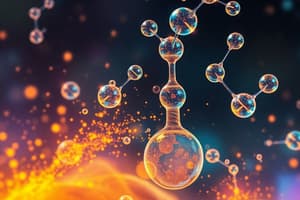Podcast
Questions and Answers
Which property is commonly exhibited by transition metals?
Which property is commonly exhibited by transition metals?
- Exhibit variable oxidation states (correct)
- Show no color in their compounds
- Do not form colored compounds
- Do not act as catalysts
In the given reactions, what role does Pd - BaSO4 play?
In the given reactions, what role does Pd - BaSO4 play?
- Acid catalyst
- Base catalyst (correct)
- Reductive agent
- Oxidizing agent
Which of the following reactions represents the Cannizzaro reaction?
Which of the following reactions represents the Cannizzaro reaction?
- $CH_3-CH = CH - CH_2OH > + H$
- $CH_3 COCl$
- $OH | CH_3CHCH_3 Cu > 573K PCC$ (correct)
- $CH_3OH + CH_3CH_2COOH$
Why do O-nitrophenol is more volatile than p-nitrophenol?
Why do O-nitrophenol is more volatile than p-nitrophenol?
What is a common characteristic of Hoffmann bromamide reaction?
What is a common characteristic of Hoffmann bromamide reaction?
Why does light travel through optical fibers?
Why does light travel through optical fibers?
Which type of image is formed by the objective lens of a compound microscope?
Which type of image is formed by the objective lens of a compound microscope?
What is the effect of light traveling through a compound Microscope?
What is the effect of light traveling through a compound Microscope?
How is the image created by a compound Microscope described?
How is the image created by a compound Microscope described?
What phenomenon allows light to travel through optical fibers?
What phenomenon allows light to travel through optical fibers?
In a compound microscope, what type of image is magnified by the objective lens?
In a compound microscope, what type of image is magnified by the objective lens?
What is the power consumption in the A.C. circuit with current I = 5 sin(100 – π/2) amp and A.C. potential V = 200 sin(100t) volt?
What is the power consumption in the A.C. circuit with current I = 5 sin(100 – π/2) amp and A.C. potential V = 200 sin(100t) volt?
What is the root mean square (r.m.s) value of the current in the A.C. circuit with I = 5 sin(100 – π/2) amp?
What is the root mean square (r.m.s) value of the current in the A.C. circuit with I = 5 sin(100 – π/2) amp?
What formula does the Huygens wave theory describe?
What formula does the Huygens wave theory describe?
What laws can be derived from Huygens wave theory regarding light refraction?
What laws can be derived from Huygens wave theory regarding light refraction?
If a lens follows the lens formula given as 'Symbols have their general meaning', what is the general meaning of the symbols used in the lens formula?
If a lens follows the lens formula given as 'Symbols have their general meaning', what is the general meaning of the symbols used in the lens formula?
Which of the following properties are commonly exhibited by transition metals?
Which of the following properties are commonly exhibited by transition metals?
In a lens with a refractive index of 1.5 placed in air, what refractive index of the medium would make the lens disappear?
In a lens with a refractive index of 1.5 placed in air, what refractive index of the medium would make the lens disappear?
If a glass lens has a refractive index of 1.5, what refractive index should the liquid in a trough have for the lens to appear to vanish?
If a glass lens has a refractive index of 1.5, what refractive index should the liquid in a trough have for the lens to appear to vanish?
When a lens is placed in a medium with a higher refractive index compared to the lens itself, what effect occurs on the lens?
When a lens is placed in a medium with a higher refractive index compared to the lens itself, what effect occurs on the lens?
What happens to a glass lens with a refractive index of 1.5 when placed in a liquid with a higher refractive index?
What happens to a glass lens with a refractive index of 1.5 when placed in a liquid with a higher refractive index?
If a lens made of a material with a higher refractive index than air is submerged in water, what happens to the appearance of the lens?
If a lens made of a material with a higher refractive index than air is submerged in water, what happens to the appearance of the lens?
How does changing the medium around a glass lens with a refractive index of 1.5 affect its visibility?
How does changing the medium around a glass lens with a refractive index of 1.5 affect its visibility?
Flashcards are hidden until you start studying
Study Notes
Alkyl Halides and Reactivity
- The ease of dehydrohalogenation of alkyl halides with alcoholic KOH depends on the type of alkyl halide.
- The reactivity of haloalkanes depends on the type of halogen and the alkyl group attached.
- Among the given options, 2-Chloropropane is the most reactive.
Conversion of Ethyl Alcohol
- Conversion of ethyl alcohol into acetaldehyde is an example of oxidation.
- This reaction involves the addition of oxygen to the alcohol molecule.
Ligands and Chelates
- Acetate, oxalate, cyanide, and ammonia are all ligands that can form chelates.
- A chelate is a complex ion that forms when a ligand binds to a central metal atom.
Markovnikov's Rule
- Markovnikov's rule states that in the addition of a hydrogen halide to an alkene, the hydrogen atom bonds to the carbon atom with the most hydrogen atoms already bonded to it.
- The reaction of C2H4 + HBr follows Markovnikov's rule.
Boiling Points
- The boiling point of an alkyl halide depends on the type of alkyl group and the halogen atom attached.
- Among the given options, (CH3)3C Cl has the highest boiling point.
SN Mechanism
- The SN mechanism is a type of nucleophilic substitution reaction that involves the displacement of a leaving group by a nucleophile.
- CH3Cl is the alkyl halide that undergoes SN mechanism.
Transition Metals
- Transition metals exhibit variable oxidation states due to their ability to form ions with different charges.
- They also exhibit paramagnetic behavior due to the presence of unpaired electrons.
- Many transition metal compounds are colored and act as good catalysts.
- They have high enthalpies of atomization, which is the energy required to break the bonds between the metal atoms.
Reactions and Compounds
- The reaction of sodium phenoxide with carbon dioxide produces salicylic acid.
- The reaction of ethyl alcohol with carbon dioxide produces ethanoic acid.
- The reaction of CH3CHO with H2O produces CH3CH2COOH.
Cannizzaro Reaction
- The Cannizzaro reaction is a type of redox reaction that involves the oxidation of an aldehyde to a carboxylic acid and the reduction of another aldehyde to an alcohol.
Clemmensen Reduction
- The Clemmensen reduction is a type of reduction reaction that involves the conversion of a ketone to a methylene group.
Hoffmann Bromamide Reaction
- The Hoffmann bromamide reaction is a type of rearrangement reaction that involves the conversion of a primary amide to an amine.
O-Nitrophenol and P-Nitrophenol
- O-Nitrophenol is more volatile than p-nitrophenol due to the difference in their molecular structures.
AC Circuits
- The power consumption in an AC circuit can be calculated using the formula P = VI cos(θ), where P is the power, V is the voltage, I is the current, and θ is the phase angle between the voltage and current.
- The rms value of the current is given by I_rms = I_0 / √2, where I_0 is the peak current.
Lens Formula
- The lens formula is given by 1/f = 1/do + 1/di, where f is the focal length, do is the object distance, and di is the image distance.
Huygens Wave Theory
- The Huygens wave theory proposes that every point on a wavefront serves as a source of secondary spherical waves.
- The laws of refraction can be derived from the Huygens wave theory.
Optical Fibers
- The light traveling through optical fibers is due to total internal reflection.
Compound Microscope
- The image formed by the objective lens of a compound microscope is real and magnified.
Electromagnetic Waves
- Electromagnetic waves are used to examine the crystal structure of solids.
- The ratio of the de-Broglie wavelengths of two particles with equal momenta is inversely proportional to their momenta.
Semiconductor
- In a p-type semiconductor, the impurity is a trivalent atom such as boron or aluminium.
Refractive Index
- The refractive index of a liquid can be determined by placing a glass lens of known refractive index in the liquid and observing whether it disappears or not.
Studying That Suits You
Use AI to generate personalized quizzes and flashcards to suit your learning preferences.




